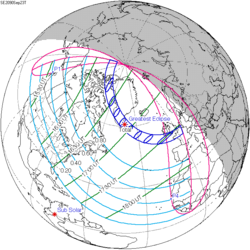| Total eclipse | |
| Gamma | −0.4492 |
|---|---|
| Magnitude | 1.0189 |
| Maximum eclipse | |
| Duration | 111 s (1 min 51 s) |
| Coordinates | 9°36′S12°12′E / 9.6°S 12.2°E |
| Max. width of band | 72 km (45 mi) |
| Times (UTC) | |
| Greatest eclipse | 11:52:21 |
| References | |
| Saros | 129 (53 of 80) |
| Catalog # (SE5000) | 9599 |
A total solar eclipse will occur at the Moon's ascending node of orbit on Tuesday, April 30, 2041, [1] with a magnitude of 1.0189. A solar eclipse occurs when the Moon passes between Earth and the Sun, thereby totally or partly obscuring the image of the Sun for a viewer on Earth. A total solar eclipse occurs when the Moon's apparent diameter is larger than the Sun's, blocking all direct sunlight, turning day into darkness. Totality occurs in a narrow path across Earth's surface, with the partial solar eclipse visible over a surrounding region thousands of kilometres wide. Occurring about 3.75 days after perigee (on April 26, 2041, at 17:50 UTC), the Moon's apparent diameter will be larger. [2]
Contents
- Path description
- Images
- Eclipse timing
- Places experiencing total eclipse
- Places experiencing partial eclipse
- Eclipse details
- Eclipse season
- Related eclipses
- Eclipses in 2041
- Metonic
- Tzolkinex
- Half-Saros
- Tritos
- Solar Saros 129
- Inex
- Triad
- Solar eclipses of 2040–2043
- Saros 129
- Metonic series
- Tritos series
- Inex series
- References
- External links




































































































